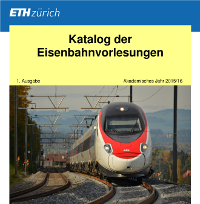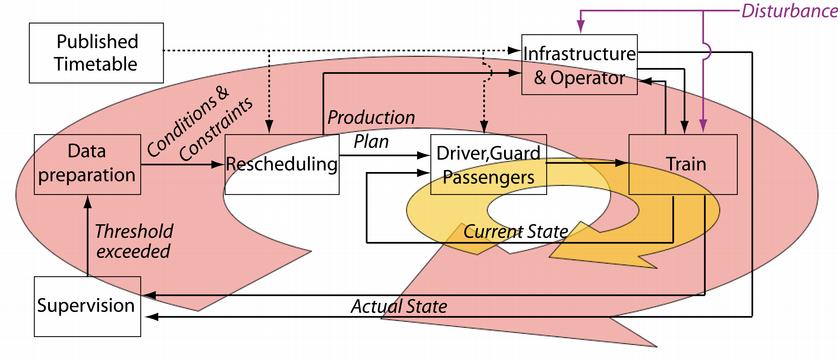|
|||||||||||
Improving the Efficiency of Heavily Used Railway Networks - A systemwide Approach
Leitung
ETH Zürich
Prof. Dr. Ulrich Weidmann
Institut für Verkehrsplanung und Transportsysteme (IVT)
HIL F 13.1
Stefano-Franscini-Platz 5
8093 Zürich
Tel: +41 44 633 33 50
Fax: +41 44 633 10 57
Rail traffic has grown rapidly within the last few years and further continuous growth is projected. Consequently, rail networks are being increasingly operated at the limits of their capacity and stability. The focus of the present thesis consists of developing a new framework in order to improve existing performance. The new framework combines dynamic traffic management solving events, conflicts and delays in real-time in combination with advice tools supporting drivers and guards to operate trains precisely following dynamically changeable schedules. This research combines recent developments in operations research and enhancements to technical systems. The thesis shows that feedback control methods can be adapted and applied for railway operations.
The integrated real-time rescheduling framework developed and introduced was designed as a superimposition of two control loops. A precise description of the framework with the outer rescheduling loop and the inner precise operation loop was used to identify all the relevant elements and processes within the framework. Based on today's operation principles and technological implementations, three main components to improve were identified for an integrated real-time rescheduling framework:
- Up-link to transmit train state and position as well as delay, incident or event information frequently and accurately. This can be achieved by using GSM-R or other communication channels. Implicitly precise position determination and synchronised times for all actors must be ensured.
- Software to handle event and delay information, identify primary delay reasons, produce adequate predictions, and generate new production plans based on enhanced operation research techniques in real-time.
- Down-link (e.g. by GSM-R) to transmit new schedules to drivers, guards and infrastructure operators as well as advice tools displaying the updated recommendations to the actors involved.
The analysis of the rescheduling loop has shown that delays and time lags may occur for all processes. Enhancements were evaluated in order to minimise the overall duration. Along with promising development for rescheduling algorithms, the new framework will make it possible that schedules can be generated and transmitted to all actors involved for a local area within 30 seconds. However, a balance must be found between nervous rescheduling due to vague data, simplifications for the algorithms generating a new schedule, and short rescheduling duration.
Visualised recommendations based on an updated schedule are at the focus of the inner accurate production control loop. It was shown how deviations arise and that supporting tools are required for all the actors involved in order to ensure accurate production. Architectures and designs of the driver-machine interface (DMI) were at the focus of the evaluations. Models showed that an operational accuracy of 15 seconds (which is required at least for a substantial efficiency improvement) may achievable as long as suitable information is provided. However, test-runs with trains using a DMI must be run in order to evaluate the accuracy achievable during daily operations.
The thesis demonstrated that the major added benefit of the new framework with the superimposition of the two feedback control loops adapted for railway operations is the opportunity to avoid conflicts by adjusting driving behaviour to precisely following dynamically changeable trajectories. In contrast to conventional rescheduling systems, where trains can only be delayed, rerouted or reordered, being able to retime and control running trains precisely is a significant improvement.
The potential benefits of the new integrated real-time rescheduling framework on stability, energy consumption and capacity usage were derived and subsequently determined by simulation evaluations and field tests for the specific areas around the main stations of Lucerne, Bern and Winterthur. The simulation tests proved that the integrated real-time rescheduling framework can significantly increase rail traffic flow and thus reduces delay propagation. In particular, early rescheduling and avoiding conflicts due to precise train operations are major benefits of the new system. Test runs showed that, in particular, reliability and robustness are considerable challenges in the development for the new system. However, it was proven that the integrated real-time rescheduling is technically feasible. With the FARE-DMI developed, an accuracy of +/- 15 seconds was achieved for test runs under regular conditions. Nevertheless, abrupt changes in the reference trajectory after rescheduling and specific circumstances were not tested. It seems that accuracy is reduced in these cases with the actual FARE display, and evaluations with other information including speed advices are recommended.
The tolerance band principle, a key element for a fast and consistent rescheduling process, was introduced. Each train is assigned a temporal tolerance in which disturbances and variations can be absorbed by the actors. Whenever a train exceeds the tolerance limit, rescheduling will be initiated. In addition, applying the tolerance band helps to make the planning process more systematical. An excessively small tolerance band results in nervous behaviour whereas an excessively large size unnecessarily reduces capacity. The tolerance band principle is comparable to the green band used in Zurich's dispatching center in order to identify possible conflicts. However, green bands were not systematically used by dispatchers.
The thesis demonstrated that clever network decomposition in condensation (capacity bottlenecks) and compensation areas (track sections with sufficient capacity) help to improve the benefits of the integrated real-time rescheduling framework. Running time supplements on feeder lines in compensation areas are used to schedule and control trains in order to enter condensation areas at the precisely specified time and at the given speed. Time- and capacityconsuming signalling influences can thus be minimised in condensation areas, which allows a seamless sequence of trains with minimum buffer times in between. It was demonstrated that combining the integrated real-time rescheduling framework with the specific operation of trains in condensation areas consequently results in the maximised capacity usage of a given infrastructure.
Further challenges can be solved by applying the new integrated real-time rescheduling framework. The prediction of train movements and connections will be more accurate. Passengers can thus be informed more precisely and at an earlier point in time about their further journey. Terminal planning and just-in-time production for freight transports are also improved because prediction is more accurate and reliable. Real-time rescheduling algorithms can be used in addition for planning long- and mid-term schedules. Various timetable and infrastructure enhancement scenarios can thus be compared. Finally, safety will be improved due to the fact that the number of closed signals approached will decrease.
Acknowledgements
We want to thank the Swiss Federal Railway Infrastructure Division, namely O. Stalder, Dr. F. Laube, Dr. R. Wüst, S. Roos and T. Graffagnino, for funding this research and for their cooperation and fruitful discussions
More Information / Literature
- Luethi M. (2009): Structure and Simulation Evaluation of an Integrated Real-Time Rescheduling System for Railway Networks, To appear in Journal of Networks and Spatial Economics
- Luethi M. (2008): Evaluation of energy saving strategies in heavily used rail networks by implementing an integrated real-time rescheduling system, Computers in Railways XI, pp. 349-358.
- Wüst R., Laube F., Roos S., Caimi G. (2008): "Sustainable Global Service Intention as objective for Controlling Railway Network Operations in Real Time." Proceedings of the 8th World Congress of Railway Research (WCRR), Seoul, Korea
- Laube, F., Mahadevan, V. (2008): "Bringing costumer focus into every nut and bolt of the railway: Swiss federal Railway's Path into the future", Proceedings of the 8th World Congress of Railway Research (WCRR), Seoul, Korea
- Laube F., S. Roos, R. Wüst, M. Lüthi, U. Weidmann (2007): PULS90 - Ein systemumfassender Ansatz zur Leistungssteigerung von Eisenbahnnetzen, ETR Eisenbahntechnische Rundschau, Ausgabe 3/2007, pp. 104 - 107.
- Luethi M., A. Nash, U. Weidmann, F. Laube, R. Wuest (2007): Increasing Railway Capacity and Reliability through Integrated Real-Time Rescheduling, Proceedings of the 11th World Conference on Transport Research, Berkeley, 2007.
- Luethi M., F. Laube, U. Weidmann (2007); Principles and Dynamic Aspects for a Rail Traffic Real-Time Rescheduling System, Proceedings of the 6th FORMS/FORMAT 2007 Symposium, eds. E. Schnieder, G. Tarnai, Braunschweig, pp. 129-136.
- Luethi M., U. Weidmann, F. Laube, G. Medeossi (2007); Rescheduling and Train Control: A New Framework for Railroad Traffic Control in Heavily Used Networks, 86th Transportation Research Board Annual Meeting 2007, Washington DC.
- Roos S. (2006) Bewertung von Knotenmanagement-Methoden für Eisenbahnen. Institute for Transport Planning and Systems, Swiss Federal Institute of Technology Zurich, 2006.
- Laube F., Schaffer H. (2006) 'Specific working results about the rescheduling process and phases for the PULS 90 project', SBB Bern, 2006.
- Wuest R. (2006) Dynamic rescheduling based on predefined track slots. In Proceedings of 7th World Congress on Railway Research, Montreal, 2006.
- Stalder O. and F. Laube. (2004) The efficient Railway – a Field of Action for Formal Methods. In Proceedings of 5th FORMS Formale Technik für Automatisierung und Sicherheitssysteme im Eisenbahn- und Automotivebereich Fachtagung, Technical University Braunschweig, 2004.
- Laube F., Schaffer H. (2003) 'Specific working results about strategic network division for the PULS 90 project', SBB Bern, 2003.
- Stalder O., F. Laube and T. Graffagnino. (2003) "Increasing performance of the rail network in the heart of Europe: A program for the Swiss Federal Railways", International symposium on speed-up and service technology for railways and maglev systems, Tokyo, The Japan society of mechanical engineers, 2003.
More Literature from the IFOR about Rescheduling algorithms
- G. Caimi, D. Burkolter, T. Herrmann, F. Chudak, M. Laumanns (2009) "Design of a railway scheduling model for dense services." Accepted for publication in Networks and Spatial Economics, March 2009.
- G. Caimi, M. Fuchsberger, M. Laumanns, K. Schüpbach (2007): "Periodic Railway Timetabling with Event Flexibility." Proceedings of ATMOS Workshop, November 2007.
- G. Caimi, , D. Burkolter, T. Herrmann, F. Chudak, M. Laumanns (2007): "Design of a new railway scheduling model for dense services." In: ISROR Proceedings, March 2007.
- Herrmann T., D. Burkolter, G. Caimi (2006): "Bewertungsgrundlagen ausgelasteter Fahrpläne." In: Verkehr und Technik, Erich Schmidt Verlag, August 2006.
- Burkolter D., T. Herrmann and G. Caimi. (2005) Generating Dense Railway Schedules. In Advanced OR and AI Methods in Transportation, Publishing House of Poznan University of Technology, 2005, pp. 290-297.
- Burkolter D. (2005) Capacity of Railways in Station Areas using Petri Nets. Institute for Operations Research, Swiss Federal Institute of Technology Zurich, 2005.
- Herrmann T. (2005) Stability of Timetables and Train Routings through Station Regions. Institute for Operations Research, Swiss Federal Institute of Technology Zurich, 2005.
Contact
|
For more information, please contact: Marco Luethi Swiss Federal Institute of Technology ETH Zurich Wolfgang-Pauli-Strasse 15 IVT - HIL F34.2 8093 Zurich Switzerland Phone: +41-44-633-2415 Fax: +41-44-633-1057 luethi/at/ivt.baug.ethz.ch |
Wichtiger Hinweis:
Diese Website wird in älteren Versionen von Netscape ohne
graphische Elemente dargestellt. Die Funktionalität der
Website ist aber trotzdem gewährleistet. Wenn Sie diese
Website regelmässig benutzen, empfehlen wir Ihnen, auf
Ihrem Computer einen aktuellen Browser zu installieren. Weitere
Informationen finden Sie auf
folgender
Seite.
Important Note:
The content in this site is accessible to any browser or
Internet device, however, some graphics will display correctly
only in the newer versions of Netscape. To get the most out of
our site we suggest you upgrade to a newer browser.
More
information




